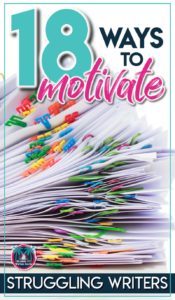The Big List of Ways to Motivate Struggling Writers
There are few things in the ELA teaching world worse than when a student flat out refuses to write. It happens for a myriad of reasons. Students lack confidence, interest, background knowledge, or research skills. They don’t know where to start, aren’t sure how to find inspiration, don’t feel comfortable approaching the teacher for help, or don’t know how to get past writer’s block. We can help them if we try to view the experience of writing through their lens.
So, what are some reasons why students dislike writing? Understanding the causes impacts how we should alter instruction to motivate struggling writers.
Problem 1: The task seems overwhelming.
Commonly, students feel like writing an entire essay isn’t possible. When students struggle to form complete sentences, it’s overwhelming for them to think about writing an entire essay. We can build students’ confidence in their writing abilities by scaffolding the process.
1. Make tasks bite-size. One way to to that is by breaking down the writing process. Ask students to draft a sentence, and then walk them through the entire revising and editing process with just that sentence. This free resource will walk you through the process. You can try this with any genre of writing.
2. Give frequent feedback. Once they are confident with sentence writing, move on to a paragraph. Instead of explaining expectations for every paragraph of the entire essay, just talk about one paragraph at a time. Conference with students, and help struggling writers by giving them frequent feedback so they know they are on the right track before attempting the next step.
3. Try out collaborative writing. It cuts down on your grading time and also gives struggling writers a smaller task to master, offers Ashely from Building Book Love. You can learn more about this strategy under the fifth tip in this post: Five Essay Grading Tips.
4. Scaffold thesis statements. Abby from Write on with Miss G has students write a formulaic 3-pronged thesis and then transform it into an open-ended, advanced thesis statement. She says this graphic organizer can help your students graduate to the thesis statements that you want to see in their writing.
Problem 2: Students are confused about the expectations.
Sometimes students simply do not understand what the teacher wants from them. Teachers ask students to write an essay, and students become overwhelmed.
5. Be clear up front. Lauralee from Language Arts Classroom recommends we explain our expectations and domain-specific vocabulary to students. Read how to introduce expectations to students, and see an editable introductory presentation.
6. Differentiate and scaffold how you explain expectations. Try explaining expectations to students in different ways. For instance, set individual student goals based on a pre-assessment. Model writing, analyze samples, and write as a class. Use memorable acronyms and graphic organizers or color-coded graphic organizers to help anchor abstract concepts.
Problem 3: Students believe their ideas are not worth writing.
“I have nothing to write.” We’ve heard it before. Everyone’s voice matters, but not all secondary students believe it. Students need to practice sharing their ideas with others in order to build their confidence muscles.
7. Use introductory activities. Before starting a creative writing project, Language Arts Classroom suggests, stress to students that they all have a powerful voice, a voice they should share. Sometimes, students think they do not have anything “worth” writing about. With these introductory activities, teachers can emphasize that everyone has something worth saying.
8. Create a makerspace corner. Another approach that is growing in popularity, thanks to Angela Stockman, is the concept of a makerspace. When reluctant writers are given the opportunity to make and manipulate their thoughts before vocalizing them, they begin to understand the power of their ideas.
9. Let students choose the topic. Students are more likely to be confident in writing about a topic of interest. Providing topic choice is a simple way to get past writer’s block for some students.
Problem 4: The pace is too quick.
Anyone, not just a struggling writer, becomes overwhelmed when they have more to do than time available to do it in. Covering fewer writing skills in depth is better than covering every skill quickly if we want students to grow.
10. Differentiate expectations based on readiness. Teachers need to know: It’s okay to differentiate expectations with writing assignments. We have to consider students’ readiness levels and meet them where they are. For example, if you are working with a group of students who lacks experience with research and essay writing, try building confidence by just asking them to write one solid body paragraph instead of three. If your students have never done any research writing at all, just start with a research paragraph. Or, focus on growth between rough and final draft when grading.
11. Use interactive bulletin boards. Ashley from Building Book Love suggests another way to motivate struggling writers is to help them help themselves. So many times both students and teachers become frustrated during writing conferences because time is limited and it’s difficult to think on the spot. To remedy this, set up an interactive bulletin board in which you can direct students to mini lessons that they can comprehend and implement at their own pace.
12. Try a hyperdoc. Abby from Write On with Miss G recommends providing a hyperdoc of resources. The writing process is discursive, messy, and unique to each writer, so she believes a hyperdoc is the perfect way to accommodate all of your writers, no matter where they are in the process. It’s basically a collection of resources that allows students to work through the writing process at their own pace, and it allows the teacher more flexibility to conference with writers. Here are Abby’s writing minilessons. For more information on how to create hyperdocs to support your students, check out this blog post.
Problem 5: Writing is hard. Avoidance is easier.
Student writers can get discouraged easily because writing is tough. Students use a wide variety of avoidance tactics to get out of writing. Some say they have no ideas, others stare blankly at their screen or paper, and still others crank something out and shout, “Done!” entirely too soon.
13. Use writing charts. My friend Amanda Write Now notes it is important to be prepared for these situations. We can use writing charts to help struggling writers overcome these hurdles. You will also find useful information in this free video and in this article, Support for Writers at All Levels.
14. Make feedback count. The way we respond to the presence of students’ writing will determine whether or not they produce more…as well as the quality of their work. When giving feedback or grading writing, we have to respect students’ internal dialogue. Writing is a vulnerable task for many students. In order for them to open up, they need to trust us. Try clarifying the audience’s view or asking questions instead of making statements. Read more specifics in this post.
15. Discuss writing stamina. If we want students to live in metacognition, we need to train them. Have a conversation about writing stamina with students, and involve them in the brainstorming process. Teach them to pivot from complaining about not wanting to do it to figuring out how to change that mindset and overcome the hurdle. Hang their ideas as anchor charts so they can re-read and self-monitor as needed during work time.
Problem 6. Students view writing as a chore.
Sometimes writers struggle because they need a break from academic writing. When we ask students to write, oftentimes frustration comes from repeating the same writing tasks over and over again. Even for the most verbose writer, a shift in medium and in writing task can be a confidence-booster.
16. Change the platform. For your next attempt at narrative, Amanda from Mud and Ink Teaching suggests, consider having students write choose-your-own-adventure style stories. It’s really easy to do, and it just takes a few, free training videos on how to link together Google Slides. Students are relieved of the pressure of writing “pages” of narrative and instead directed to compose in Google slides. This resource will get you and your students started with writing and imagining alternate endings to the stories that you’re reading in class.
17. Get them excited with the fun stuff. Amanda Write Now also reminds us that it is important to sprinkle in some fun types of writing into your school year. When students get excited to write, their stamina and experience grows. She put a huge list together! Here are 50 Ways to Get Kids Begging to Write More.
18. Try writing challenges. Mud and Ink Teaching notes that to break up the monotony, you can offer students writing challenges – especially in poetry. Every year, she uses a combination of these 30 Poems in 30 Days challenges. Giving students creative, challenging, poetic assignments helps them break through their frustration and tackle other types of writing assignments with new vision later on down the road.
There’s not a one-size-fits-all solution to help struggling writers. The reason behind each student’s reluctance is different. In this post, we’ve explored six different causes for lack of writing motivation and offered possible interventions for each. Tell us: What would you add to the list?
Still looking for more ways to support struggling writers? Try these related posts.
14 Ways to Support Struggling Writers
Tips for Scaffolding the Multiple-Paragraph Essay
How to Teach Conclusion Paragraphs
10 Tips for Responding to Student Writing


I love what you’ve written here, absolutely, we as EFL TEACHERS suffer fro this issue in particular, our learners find it challenging for them to write paragraphs but we keep motivating the to do through reading, easy tasks, group work……….etc
That’s great, Maria! Keep doing what you’re doing. 🙂 Your students are lucky to have you.